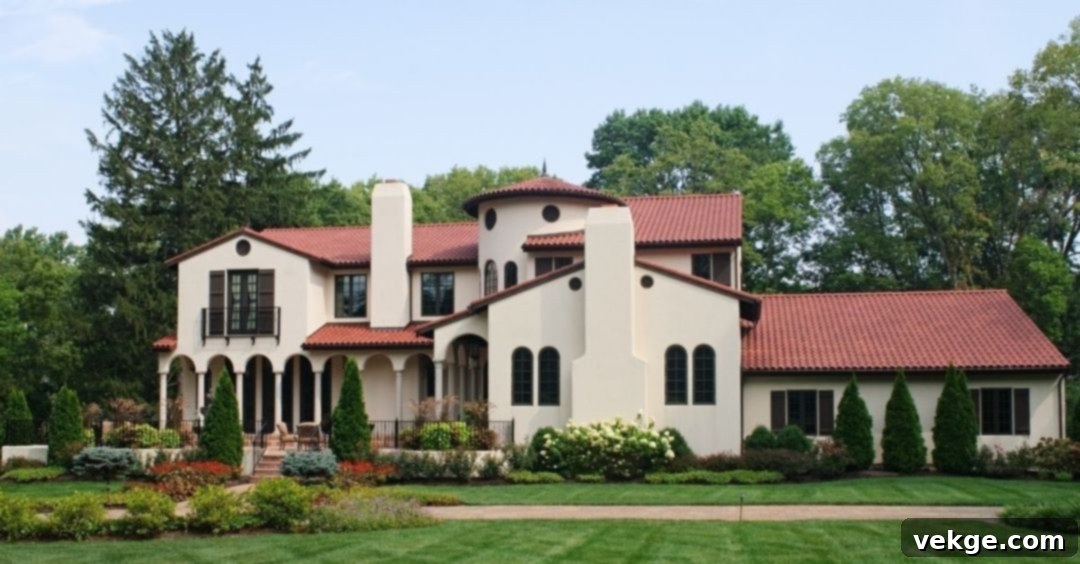Discover the Enduring Charm: A Comprehensive Guide to Spanish-Style Homes and Their Unique Architecture
The indelible mark of Spanish colonization on American culture and landscape is perhaps most beautifully showcased through its enduring architectural influence. Dating back to the late fifteenth century, when the first Europeans, the Spaniards, set foot in the New World, a distinct architectural style began to emerge. This legacy is strikingly visible today in the abundance of Spanish-style homes that gracefully dot regions once under Spanish rule, offering a tangible connection to a rich historical past.
These captivating Spanish colonial-style buildings are predominantly found in the warmer, sun-drenched coastal areas of California, the vibrant landscapes of Florida, and the arid, scenic expanses of Arizona and New Mexico. Beyond these historically dominant areas, a significant number of these charming homes also grace cities and towns in states like New Jersey, Missouri, and Nevada, demonstrating the widespread appeal and adaptability of this unique design.
Current real estate listings reveal that approximately one percent of houses in California, New Mexico, Florida, and Arizona proudly showcase Spanish-style architecture. While this represents a mere 0.11% of homes nationwide, it strongly underscores the style’s concentrated popularity and deep cultural roots in the specific regions historically colonized by Spain. These homes are not just structures; they are living testaments to a bygone era, reimagined for modern living.
What Defines Spanish-Style Homes?
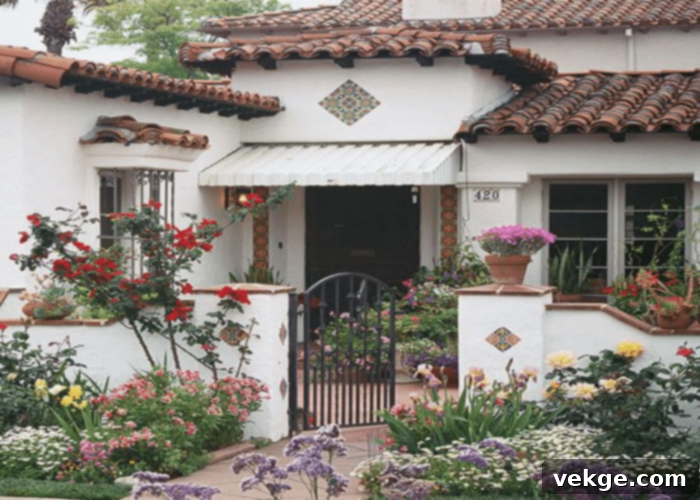
The architectural splendor of Spanish colonial homes is immediately recognizable through a collection of signature styles and elements, making them distinct from other forms of residential architecture. Drawing inspiration from traditional Mediterranean homes, these structures are particularly favored in warmer coastal and dry inland regions due to their inherent energy-efficient designs. Many of these colonial-era houses are also emblematic of the Spanish Colonial Revival Movement, which beautifully blends historic colonial aesthetics with modern sensibilities and comforts, creating homes that are both timeless and functional.
Identifying the Quintessential Spanish-Style Home: Key Architectural Features
To truly appreciate Spanish-style architecture, it’s essential to delve into the distinctive features that consistently set these homes apart from other architectural styles. Each element serves both an aesthetic and a practical purpose, deeply rooted in the climate and building traditions of the Iberian Peninsula.
1. The Iconic Tiled Roof
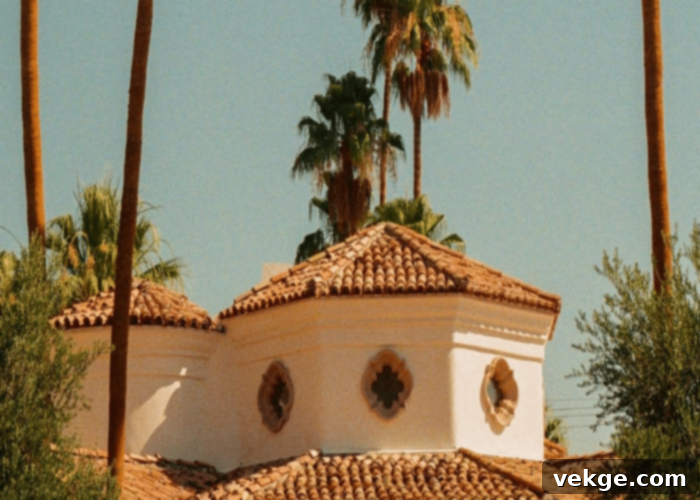
One of the most striking and universally recognized features of a Spanish-style home is its distinctive tiled roof. When Spanish colonizers arrived in the Americas, they ingeniously utilized readily available local materials to construct their dwellings. This led to the widespread adoption of red barrel terracotta tiles, crafted from indigenous clays. These roofs typically feature a low pitch, though some regional variations include flat roofs or those with a very slight incline, all designed to complement the local climate.
The inherent advantage of these red clay tiles extends beyond their aesthetic appeal. Their exceptional thermal mass helps to insulate the interior, keeping homes significantly cooler during the warm seasons. This natural cooling property makes terracotta roofs an ideal and sustainable choice for regions characterized by hot climates, contributing to both comfort and energy efficiency.
2. Graceful and Distinctive Arches
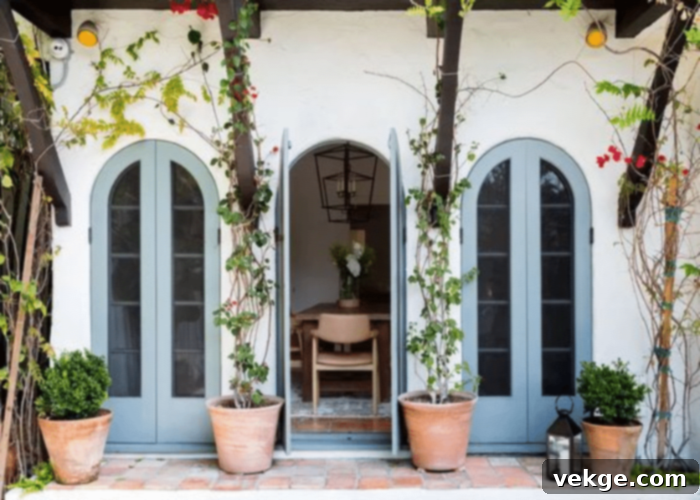
Soft, elegant arches are a ubiquitous and defining characteristic present throughout nearly all Spanish-styled homes. These architectural curves are integrated into various structural elements—adorning windows, framing doorways, defining corridors, and gracing grand entrances. The gentle curvature of these arches creates a profound visual and psychological effect, lending an immediate sense of airiness, tranquility, and fluid movement within the space. They soften the otherwise rigid lines of the structure, inviting a calm and open atmosphere.
3. Thoughtfully Sized Windows and Impressive Carved Doors
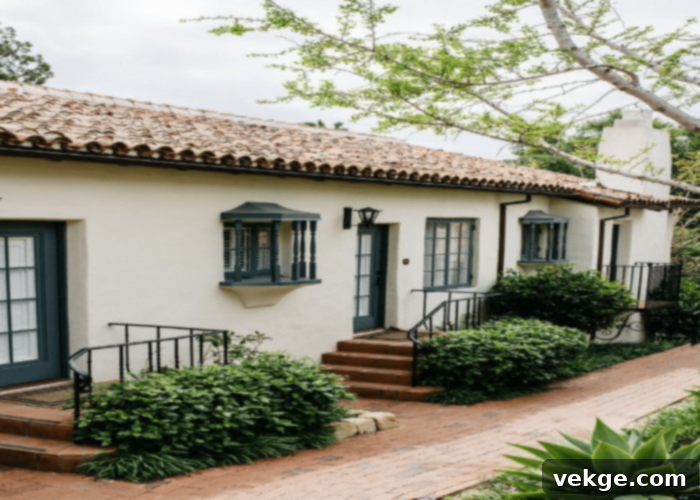
A unique balance in Spanish homes is struck between the presence of typically small-sized windows and grand, often elaborately carved doors. Both elements frequently incorporate the characteristic arched top. The doors themselves are notably large, heavy, and robust, traditionally crafted from sturdy wrought iron or rich, dark wood. Wooden doors are often embellished with intricate carvings, showcasing exquisite craftsmanship and adding a layer of ornate detail.
The impressive size and thickness of these doors serve a practical purpose, helping to regulate interior temperatures, maintaining a pleasant and comfortable environment by providing excellent insulation. In contrast, the windows are generally small and fewer in number compared to most modern homes, a design choice rooted in historical climate control and security considerations.
Historically, windows in authentic Spanish homes were often fitted only with decorative iron bars or grills, lacking glass panes. Wooden shutters were a far more common fixture for privacy and light control. Today, however, most modernized Spanish-style homes have adapted to contemporary living by incorporating glass panes into their windows, blending traditional aesthetics with modern comfort and efficiency.
4. Radiant White Stucco Walls
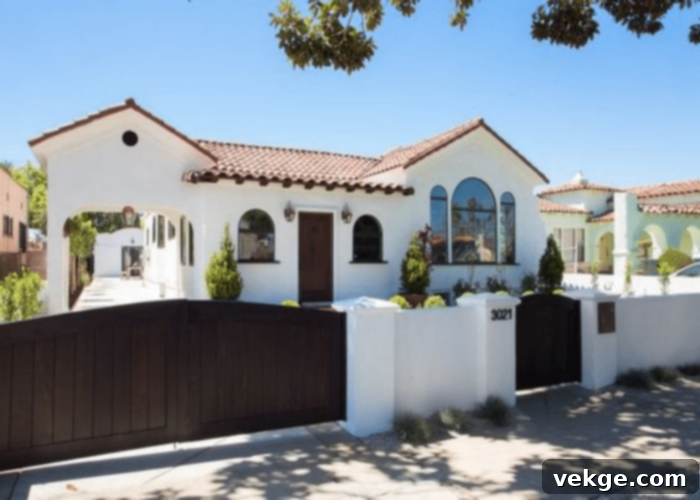
Spanish colonial homes characteristically feature robust walls constructed from either concrete or stucco, with stucco being the more prevalent and iconic choice. These walls are almost invariably painted a brilliant white. The gleaming white interiors serve a crucial functional purpose: the light color reflects sunlight, effectively helping to keep the indoors cool, a vital feature in warm climates. Additionally, the walls are often constructed with significant thickness, a design detail that further aids in retaining cool air during the day and circulating any residual warmth during the cooler nights, providing natural climate regulation.
The exterior facade of these homes is also predominantly finished with stucco and painted white. This choice is not merely aesthetic; stucco is a highly durable and weather-resistant material, offering excellent longevity and requiring minimal maintenance, all while being relatively cost-effective. The white exterior plays a critical role in preventing heat absorption, ensuring that the home remains as cool as possible. Intricate wrought iron details, such as railings, window grills, or decorative accents, stand out elegantly against the stark white stucco walls, adding a layer of sophisticated visual contrast.
5. Lofty Ceilings and Exposed Wooden Support Beams
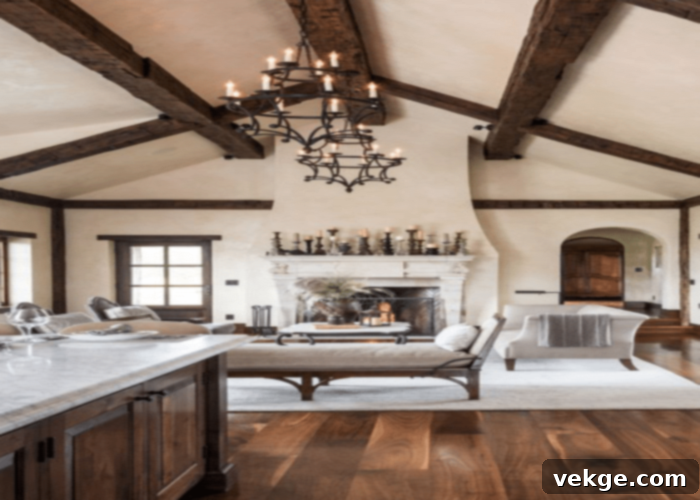
A hallmark of these classic colonial homes is the presence of high ceilings, often supported by visible, rustic wooden beams. This combination immediately evokes a sense of spaciousness and an authentic, rustic charm within the indoor architectural essence. To complement the grandeur of the high ceilings and the raw beauty of the exposed wood beams, interiors are frequently adorned with traditional terracotta pots, beautifully tiled hearths, and comfortable, inviting couches and sofas, creating a harmonious blend of rugged elegance and cozy comfort.
6. Elegant Minimalism with Ornate Accents

Spanish-style homes are characterized by an overarching sense of minimalistic decor, favoring clean lines and uncluttered spaces, yet they are punctuated by thoughtfully placed ornate embellishments and vibrant, colorful tile accents. These homes are typically either single or two-story structures, designed for practical elegance. Beyond the interiors, stonework or decorative tiles are frequently incorporated into outdoor spaces, adding texture and visual interest to courtyards, pathways, and patios, enhancing the connection between the home and its natural surroundings.
7. The Inviting Courtyard
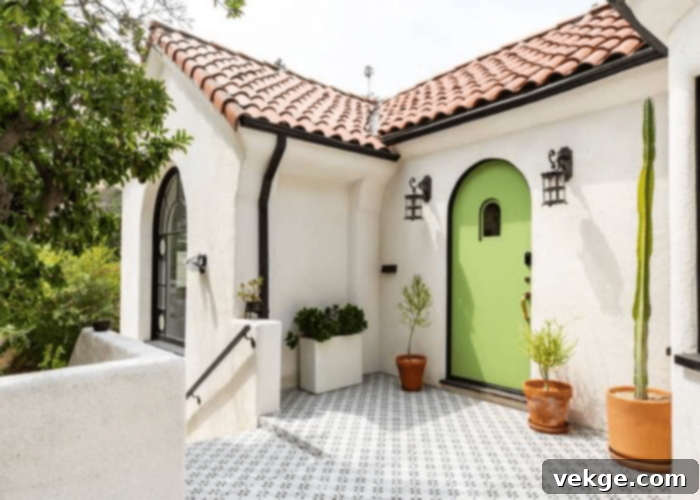
Courtyards are an intrinsic and defining feature of Spanish-style homes, serving as central outdoor living spaces. Historically, ancient Spanish homes often centered around a main courtyard, providing privacy and a natural cooling effect. In contemporary adaptations, these welcoming outdoor areas might be situated to the side or rear of the house, or even integrated within an L-shaped floor plan. Whether nestled in the middle, to the side, or at the rear, the courtyard consistently functions as an essential outdoor sanctuary for relaxation, unwinding, and entertaining guests, fostering a seamless indoor-outdoor living experience.
8. Intricate Wrought Iron Details
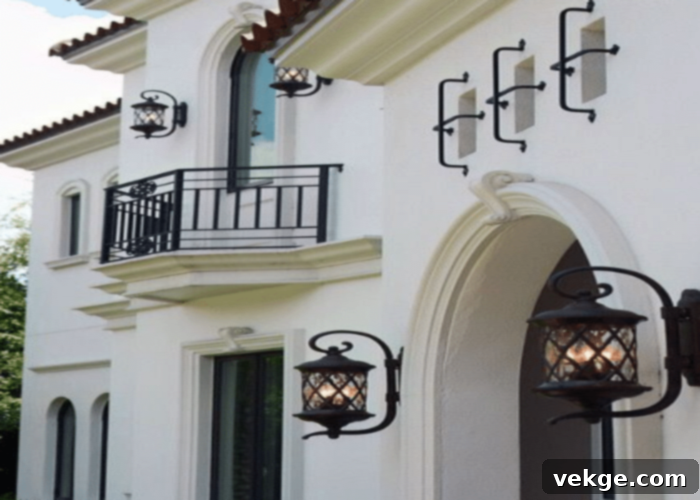
Intricate wrought iron details are a prominent and beautiful feature in most Spanish-styled homes, adding both decorative flair and functional strength. This enduring material is commonly seen in a variety of applications, enhancing the aesthetic appeal of railings, stair banisters, balconies, window grills, and light fixtures. The dark, artisanal craftsmanship of wrought iron contrasts strikingly with the white stucco walls and warm terracotta, creating a sophisticated and historically authentic visual texture.
Exploring the Diverse Types of Spanish-Style Homes
Spanish colonial architecture has evolved and adapted across different regions of the United States, giving rise to several distinct styles, each with its unique characteristics.
1. The Floridian Style
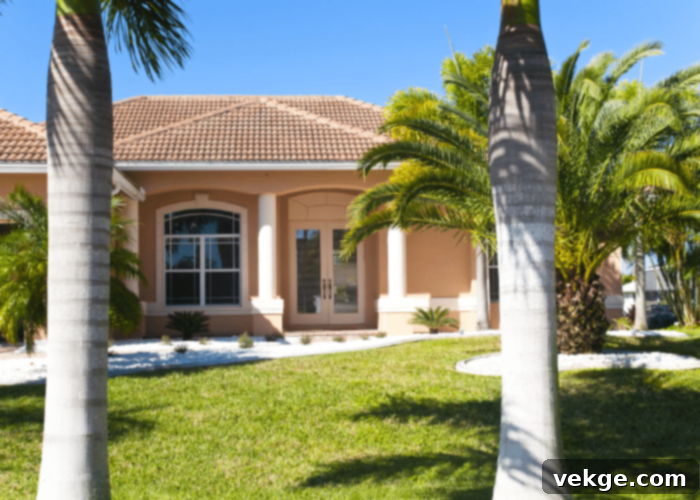
Spanish-style houses found in Florida exhibit a unique character, often differing from those in other parts of the US. These Floridian homes frequently display a distinct Baroque influence, reflecting the specific historical and cultural currents that shaped the region. Visible features commonly include more ornate exteriors, grand ornamented columns, and windows that often feature geometric shapes, contributing to a more elaborate and decorative facade compared to other Spanish Revival styles.
2. Spanish Eclectic Architecture
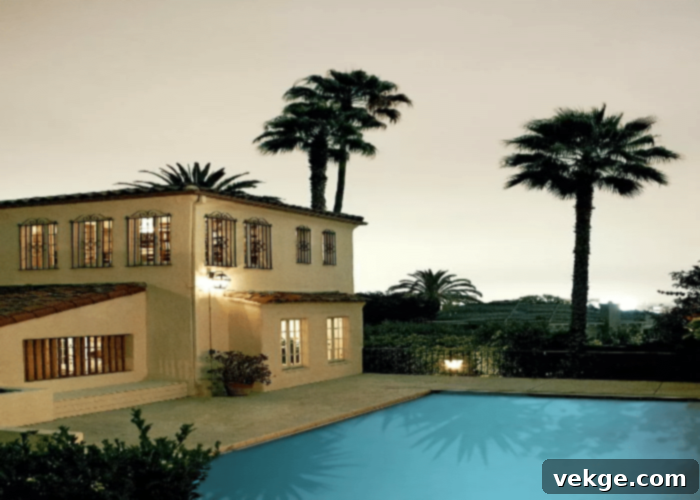
Spanish Eclectic homes represent a fascinating chapter in the Spanish Revival architectural movement. While they retain core elements like the classic terracotta roofs and pristine white stucco walls, these homes are celebrated for their integration of modern elements and diverse influences. This style often incorporates features such as bay windows, and other unique elements borrowed from Moorish, Mediterranean, or even Pueblo Revival architectural traditions, resulting in a rich, hybridized aesthetic that is both traditional and uniquely expressive.
3. The Mission Revival Style
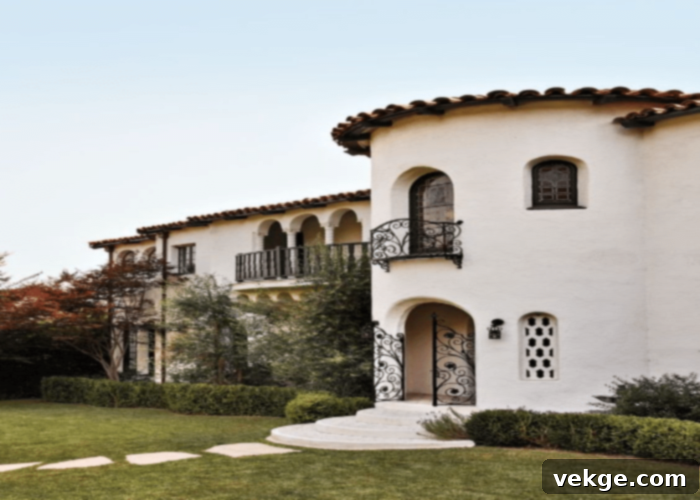
Mission Revival homes are particularly prevalent in California, drawing direct inspiration from the historic Spanish missions scattered across the state. Characteristic features include low-pitched tiled roofs, smooth stucco walls, and prominent arched doorways and windows. A distinctive element of some Mission Revival homes is the presence of decorative parapet walls or even ornamental bell towers, harkening back to the original mission structures. This style beautifully encapsulates the simplicity and grandeur of California’s colonial past, often blending with elements of the Arts and Crafts movement.
Conclusion: The Enduring Appeal of Spanish-Style Homes
The classical beauty of Spanish-style homes, particularly prevalent on the West Coast of the US, with their elegant arches, inviting outdoor fireplaces, charming tiled courtyards, and distinctive terracotta roofs, speaks volumes about the enduring legacy of Spanish colonial architecture. These residences are more than just buildings; they are cultural statements, brimming with rustic vibes and a timeless appeal that continues to captivate homeowners.
From the sun-drenched landscapes of California to the picturesque Riviera in Florida, and across the vast expanses of New Mexico and Arizona, Spanish-style homes remain a common and cherished sight. The profound influence of Spanish design is especially evident in the Southeast and Southwest regions of the United States. Elementally, such homes are ideally suited for hot and dry weather conditions, thanks to their intelligent design choices like thick stucco walls and insulating tiled roofs, making them a practical and beautiful choice for their environments.
If you are a fortunate homeowner of an elegant residence inspired by Spanish architecture, we encourage you to share the unique features and captivating pictures of your home. Your insights and visuals can serve as a wonderful source of inspiration for our readers, sparking ideas for them to infuse their own homes with the timeless charm and distinctive architectural elements of the Spanish style.
